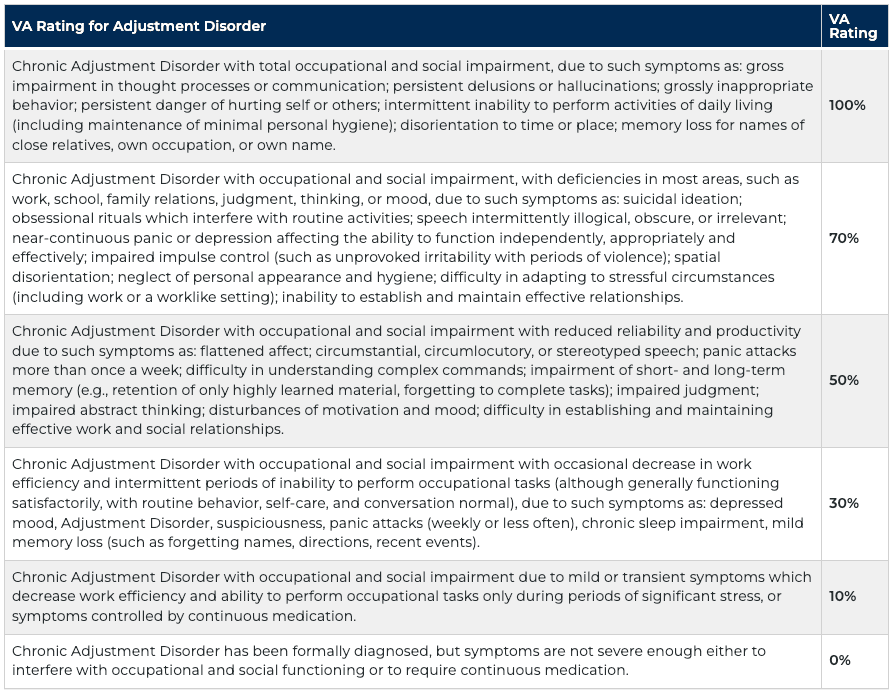Looking for Expert-Level VA Claim Answers?📱Call Us Now! 737-295-2226
If you’re struggling with adjustment disorder, it may feel lonely and isolating, but you’re not alone.
Many veterans experience emotional and behavioral struggles throughout their daily lives, due to the significant life changes and challenges that come with military service and transitioning to civilian life.
Symptoms can range from anxiety and depression to social withdrawal and difficulty concentrating. They can be overwhelming and may affect your ability to work, maintain relationships, and engage in daily activities.
While identifying what the condition is and where it came from is complex and difficult, navigating the VA disability rating system can be just as challenging. Understanding how the adjustment disorder VA rating system functions is crucial to securing the benefits you deserve.
In this guide, we will break down:
- How the VA rates adjustment disorder
- Eligibility criteria
- Adjustment disorder VA ratings
- How to prove service connection and more
Keep reading and learn how to maximize your adjustment disorder VA rating!
Table of Contents
Summary of Key Points
- Adjustment Disorder Definition: Adjustment disorder is a mental health condition triggered by significant life changes or stressors, leading to emotional and behavioral symptoms.
- Service Connection: Establishing a direct link between military service events and the onset of adjustment disorder is crucial for VA disability claims.
- VA Rating Criteria: The VA evaluates chronic adjustment disorder based on symptom severity and impact on occupational and social functioning, with ratings ranging from 0% to 100%.

Understanding Adjustment Disorder
Adjustment disorder is a mental health condition characterized by emotional or behavioral symptoms, brought on by identifiable stressors, such as significant life changes or traumatic events. For veterans, these stressors often stem from military service, including combat exposure, loss of comrades, or transitioning to civilian life. Symptoms may manifest as anxiety, depression, or behavioral changes, significantly impairing daily functioning.
Common Symptoms
- Persistent feelings of sadness, hopelessness, or worthlessness
- Anxiety, excessive worry, or nervousness
- Social withdrawal and difficulty maintaining relationships
- Difficulty concentrating or making decisions
- Insomnia or excessive fatigue
- Suicidal thoughts or tendencies in severe cases
Proving Service Connection
To be eligible for a chronic adjustment disorder VA rating, you must meet three (3) criteria by law:
- A current medical diagnosis of adjustment disorder, in a medical record (Service Treatment Records, VA medical records, or private medical records)
- Your adjustment disorder was caused or made worse by your active-duty military service OR by another service-connected disability for secondary service connection
- Persistent and recurring symptoms of adjustment disorder (“Severity of Symptoms”), including how it affects your work, life, and social functioning
Successfully proving a service connection necessitates a clear connection between military service and your adjustment disorder. Comprehensive evidence and professional medical opinions are instrumental in this process.
Pro Tip: The VA may require a C&P exam to assess the severity and service connection of the adjustment disorder. Preparation and honesty during this evaluation are crucial.
3 Main Ways to Get a VA Rating for Adjustment Disorder
There are 3 primary ways a veteran can get a VA disability rating for Adjustment Disorder: Direct service connection, secondary service connection, or as a symptom of another ratable mental disorder.
Direct Service Connection
Direct service connection for Adjustment Disorder with a VA rating of 0%, 10%, 30%, 50%, 70%, or 100%. Depending upon your formal diagnosis, you might see Adjustment Disorder with Depressed Mood or Adjustment Disorder with Anxiety. Regardless of your diagnosis, they are all rated on the same scale from 0 percent to 100 percent.
Secondary Service Connection
Secondary service connection for Adjustment Disorder connected to another service-connected disability with a rating of 0%, 10%, 30%, 50%, 70%, or 100%. For instance, a veteran might be rated for Adjustment Disorder with Depressed Mood secondary to Tinnitus.
Adjustment Disorder as a Symptom of Another Mental Disorder
Adjustment Disorder as a symptom of another ratable mental disorder such as PTSD, depression, or adjustment disorder with a rating of 0%, 10%, 30%, 50%, 70%, or 100%. For example, a veteran could be service-connected for combat PTSD with adjustment disorder. The adjustment disorder is not rated on its own but rather as a contributing symptom to another mental health condition. This is very common because it’s difficult to differentiate symptoms of mental health across multiple diagnoses.
Chronic Adjustment Disorder VA Ratings
Chronic adjustment disorder VA ratings are 0%, 10%, 30%, 50%, 70%, or 100%, depending upon the frequency, severity, and duration of your symptoms and how they affect your work, life, and social functioning.
The VA assigns disability ratings for chronic adjustment disorder based on the General Rating Formula for Mental Disorders, which evaluates the condition’s impact on occupational and social functioning. Ratings are determined by the frequency, duration, and severity of symptoms, as well as the resulting level of impairment in work, social relationships, and daily activities.
Adjustment Disorder VA Rating Chart

VA Rating Percentages
- 0%: Symptoms are diagnosed, but they do not interfere with occupational and social functioning or require continuous medication.
- 10%: Mild or transient symptoms that decrease work efficiency only during periods of intense stress, or symptoms controlled by continuous medication.
- 30%: Occupational and social impairment with occasional decrease in work efficiency and intermittent periods, where you are unable to perform occupational tasks, accompanied by symptoms like depressed mood, anxiety, or mild memory loss.
- 50%: Reduced reliability and productivity, due to symptoms such as flattened affect, frequent panic attacks (more than once a week), difficulty understanding complex commands, or impaired judgment.
- 70%: Deficiencies in most areas (e.g., work, school, family relations, judgment, thinking, or mood) due to symptoms like suicidal ideation, obsessive rituals that interfere with routine activities, illogical speech, or near-continuous panic or depression-affecting functionality.
- 100%: Total occupational and social impairment, manifested by symptoms such as persistent delusions, grossly inappropriate behavior, persistent danger of self-harm or harm to others, or severe memory loss for names of close relatives, own occupation, or own name.
Note: It’s important to note that the VA considers the overall impact of symptoms on daily life, rather than focusing solely on specific symptoms.
Adjustment Disorder with Anxiety VA Ratings
When adjustment disorder presents with anxiety, the VA evaluates the condition under the same General Rating Formula for Mental Disorders. The presence of anxiety can influence the severity assessment, potentially leading to higher disability ratings. For instance, frequent panic attacks or constant anxiety may result in a 50% or 70% VA rating, depending on the level of occupational and social impairment.
VA Rating for Adjustment Disorder with Anxiety and Depression
The coexistence of anxiety and depression with adjustment disorder can compound the severity of symptoms, affecting various aspects of life. The VA assesses the combined impact of these symptoms on occupational and social functioning. For example, a veteran experiencing near-continuous panic and depression that hinders independent functioning might qualify for a 70% VA rating. Each case is unique, and the VA conducts a comprehensive evaluation to determine the appropriate rating.
Filing an Adjustment Disorder VA Claim
Initiating a VA claim for adjustment disorder involves several critical steps:
- Prepare and Submit VA Form 21-526EZ: This form is the official application for disability compensation. Ensure all sections are accurately completed.
- Provide Supporting Documentation: Include medical records, service documents, and personal statements that establish the service connection for adjustment disorder.
- Attend the C&P Exam: The VA may require a Compensation and Pension examination to assess the severity and impact of the condition.
- Review the VA Decision: If the claim is approved, the VA assigns a disability rating based on the severity of symptoms. If denied or rated lower than expected, veterans may file an appeal.
Conclusion
Your final adjustment disorder VA Rating depends upon the frequency, severity, and duration of symptoms and how those symptoms affect your “Occupational and Social Impairment.” VA disability for adjustment disorder has ratings that range from 0% to 100% with breaks at 10%, 30%, 50%, and 70%.
Sometimes, the VA treats adjustment disorder as a “symptom” connected to another ratable mental health condition, such as Post-traumatic stress disorder (PTSD), major depressive disorder, or generalized anxiety disorder. If you have more than one mental health condition diagnosed, the VA rater will select and rate the one with the most severe symptoms.
(FAQs) Frequently Asked Questions
Is adjustment disorder a VA disability?
Yes, adjustment disorder is a mental health condition rated under CFR Title 38, Part 4, Schedule for Rating Disabilities, Diagnostic Codes (DC) for Mental Disorders, 9440 Chronic Adjustment Disorder. It’s important to note that the VA only rates “Chronic Adjustment Disorder,” which means your symptoms have persisted for longer than six months.
Can I get VA disability compensation for adjustment disorder?
Yes, the Department of Veterans Affairs (VA) will pay veterans with service-connected adjustment disorder tax-free compensation each month. The amount of your VA compensation depends upon your overall VA rating.
What is the VA rating for adjustment disorder?
Chronic adjustment disorder VA ratings are 0%, 10%, 30%, 50%, 70%, or 100%, depending upon the Frequency, Severity, and Duration of your symptoms as well as “how” those symptoms affect your “Occupational and Social Impairment” – meaning your work, life, and social functioning.
How long does it take to receive a VA rating for adjustment disorder?
The timeline varies, but most claims take several months to process.
Can I work with a 100% VA rating for Adjustment Disorder?
Yes, you can! It is a myth that having a mental health condition somehow means you can’t work. In fact, you can work with any adjustment disorder VA rating. Even if you’re rated at 100% for adjustment disorder, there is no requirement or mandate that affects your work. The exception is if you qualify for TDIU, which requires proof that your condition prevents you from securing or maintaining substantially gainful employment.
Will my VA rating change over time?
The VA may re-evaluate your condition periodically to determine if your VA rating should be adjusted.
Can I receive benefits for multiple mental health conditions?
No. The VA typically rates the most severe condition, but overlapping symptoms can impact your overall VA disability evaluation.
Want Expert-Level Help With Your VA Claim? WE GOT YOUR SIX!
How does VA Claims Insider help veterans?
We make the confusing and frustrating VA claim process EASY through our 8-step proprietary system and one-on-one coaching; we’re the VA Claim EXPERTS you can trust, and YOU are never alone in this fight against the VA!
You’ll also receive VA disability expert Brian Reese’s SEM Method Blueprint—a proven formula that has helped over 25,000 veterans win their VA disability claims faster:
Strategy + Education + Medical Evidence = VA Rating and Compensation You Deserve FASTER!
Start today and unlock an exceptional level of service you deserve for serving our country:
- You’ll hear from a VA Claim Expert over email within 15 minutes of signing up today.
- You’ll hear from your Veteran Coach team within 24 hours of all inquiries during normal business days/hours.
- Our terms are simple: IF WE DON’T WIN, YOU DON’T PAY. You have nothing to lose and everything to gain!
Click the red button below to start the process of winning your VA claim right now:
About VA Claims Insider

- VA Claims Insider is the #1 most-trusted name in VA disability claims.
- Work directly with a VA claims coach who can educate you to VA claim victory.
- 25,000+ disabled veterans have served in our membership programs since 2016.
- 30% average rating increase for veterans who complete our #1 rated Elite program.
- 4.7/5.0 average rating out of 5,500+ total reviews; over 4,500 5-star reviews.
About the Author

Dan Pearce
Dan has an expansive library of content that he’s created across industries, serving as a creator for countless articles, podcasts, videos, eBooks, websites, and more. He boasts a passion for storytelling and utilizes a degree in English with a double creative writing emphasis in Fiction and Poetry Writing, in order to embolden his subject matter to unparalleled heights.




